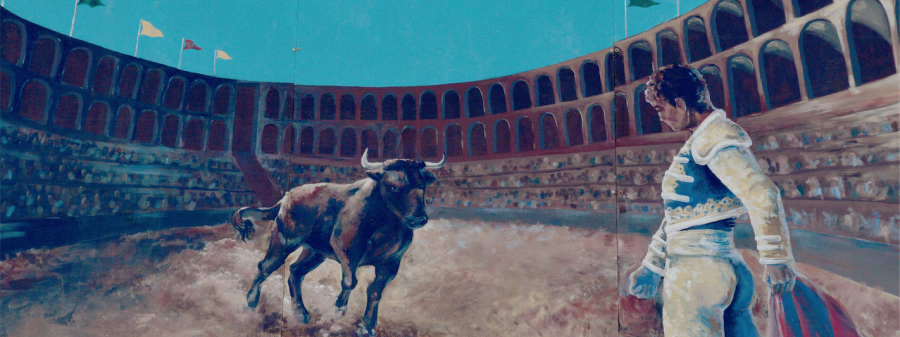hen art department chair Brian Chow first entered the MVHS gym more than 20 years ago, his eyes skimmed past the towering basketball hoops and purple banners, only to land on the mural on a wall. It contained two rows of light skinned athletes, painted in 10 variations of MVHS sports uniforms. Upon seeing this, a series of questions popped up into Chow’s head.
“Why is everyone in one tone? Or one particular race? Why is it only European?” Chow said. “I thought that was kind of an odd mural.”
The MVHS demographic was undoubtedly different when the mural was first painted. While the original intent of the piece remains unclear due to the passing of the artist and former art department chair Garrett Post, a newer audience like Chow may feel concerned from the lack of minorities represented, especially when considering today’s racial diversity.
Yet for many, that initial concern stays at just that. Students move on for the next four years, perhaps passing jokes about the mural’s stiff figures and much too trim shorts. It doesn’t concern most beyond that. To many, artwork is merely artwork. History and tradition seemingly lie beneath the 2D landscape to remain untouched.
Art and sports have gone hand in hand since the beginning of time, with murals, mascots and other imagery celebrating teams and players. But as societal views change, artworks modernize to fit new norms. With this, another remnant of the school’s past comes into question: MVHS’ mascot, the Matador.
The origins of the mascot trace back to traditional Spanish bullfighting where men, known as matadors, attempt to kill a bull using weapons with a stadium of onlookers cheering them on. Though it was once an integral part of the Spanish culture, the sport is under controversy today, and the United Nations discourages viewers under 18 from watching the sport.
While the uncomfortable undertones remain, the MVHS mascot has strayed away from the actual sport. Very few students are likely to have ever seen bullfighting, but MVHS still celebrates the matadors for their apparent valor.
The three murals outside the gym seem to reflect these conflicting interpretations of the mascot. From left to right, the murals, painted in the 1960s, portray three stages of a bullfight, with the last mural showing the matador basking in victory. Chow directed the first mural recently, with his own twist. While the other two featured the matador in the spotlight, Chow and his students made a conscious effort to stress the bull’s strength, placing the animal and matador on equal ground.
Further disparities widen the gap between the mascot and the real sport. At football games and rallies, Monte and El Toro — the infamous matador and bull of MVHS — channel a sense of friendliness between their soft costumes, a sharp contrast to the life-or-death battle of the actual sport.
Sophomore Sid Vundamatla recognizes the difference as one more reason to keep the mascot in place. As a football player, he believes that the mascots help bring a fun atmosphere to games and rallies, severing ties from the violence of real bullfighting.
“Along with the cheerleaders, they root for the [MVHS] football team to win the game,” Vundamatla said. “And, [they] make our school proud.”
By idealizing the bull and the matador’s relationship, MVHS seems to ignore the context of bullfighting. But to Principal April Scott, these distinctions between the sport and the mascot are important to MVHS’ identity.
“I have attended a Spanish bull fight so I know what they are like,” Scott said. “We have some drawings and paintings of a matador in a bull ring because a matador isn’t a matador unless there is a bull ring and a bull. But I think we as a school have diminished the fight part, and the goring of the bull and focus more on the person … [The matador] shows strength. It shows training. It shows commitment. It shows tradition.”
As for Chow, he is surprised that the mascot hasn’t changed in the last 60 years. Chow says the mascot carries offensive undertones, but a bigger problem to him is that the community doesn’t seem to care. For example, he believes the MVHS mascot, which was purchased from a school mascot store, doesn’t hold any sentimental value to anyone at MVHS.
To solve this, Chow believes the student body should take part in recreating the community, whether it’s redesigning the mascots or painting new murals that reflect the school’s racial demographic.
“It just adds to the narrative,” Chow said. “The more people that are able to do that, especially students, it just builds a richer community. Someone [will] come back, and say ‘hey, I painted that when I was in high school and it’s still there.’ It builds roots.”






